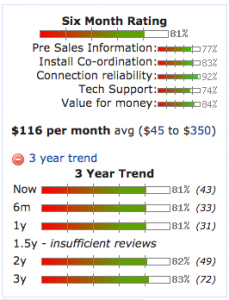
DSL Reports Rate’s Fios
When Verizon Fios first appeared on the scene in 2005, their service was one of the very few true fiber-to-the-home providers. Today there is over 740 different companies offering a fiber connection. 1 while many business only, there is no doubt that consumers want fiber connections.
Though Fios’s reception was mixed at rollout when it launched, even the New York Times asking whether it was worth the investment, 2 over the years it has gone on to become the best rated internet service by many consumer organizations including Consumer Reports, 3 The ACSI (which rates consumer’s opinions), 4 and even the FCC. 5
While Fios isn’t available in all areas, (here is a map of where it is), consumers that live in areas served by Fios still have a though choice: “Is having a fiber-optic internet connection worth while?”
To help answer this question, along with the question of “Is Fios worth the money?” we’ve compiled a quick list of third party resources that have reviewed Verizon Fios. Continue Reading
